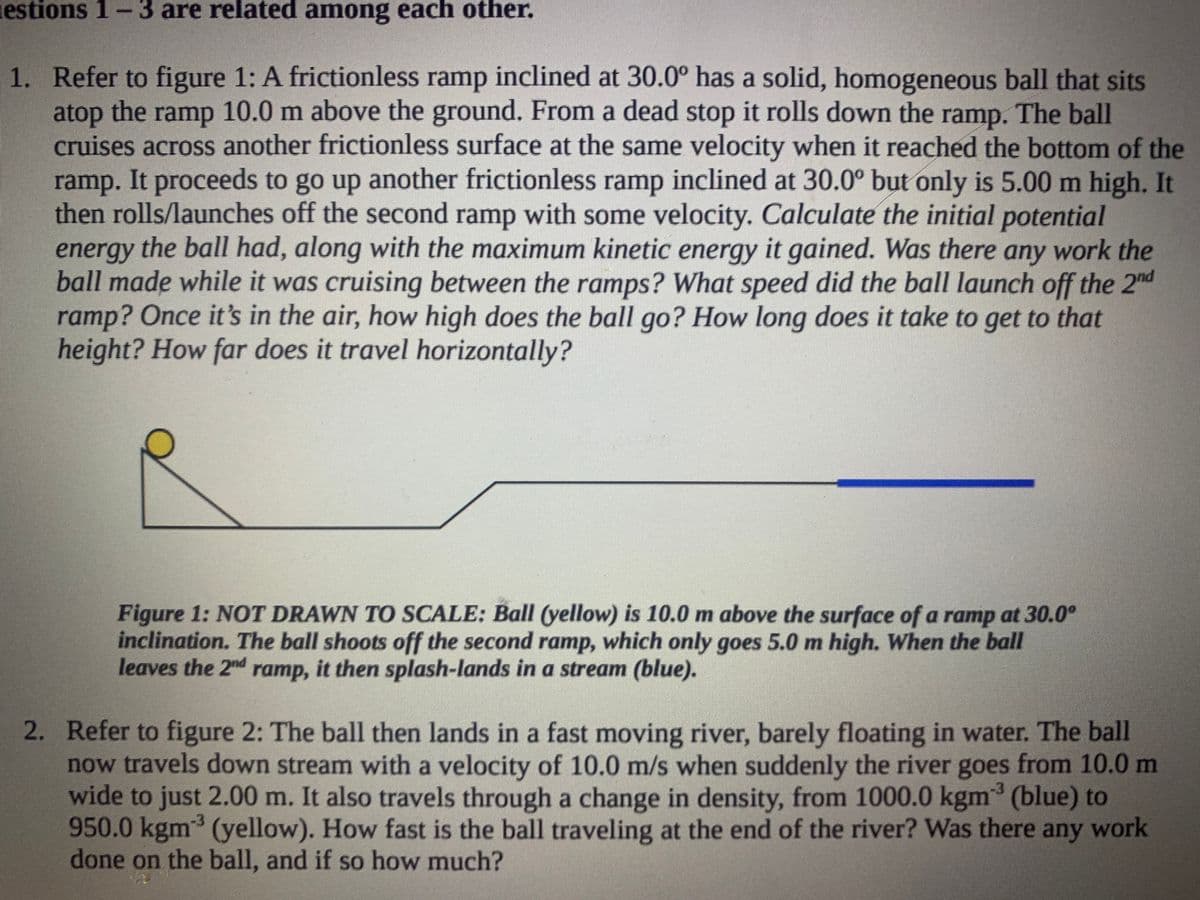1. Refer to figure 1: A frictionless ramp inclined at 30.0° has a solid, homogeneous ball that sits atop the ramp 10.0 m above the ground. From a dead stop it rolls down the ramp. The ball cruises across another frictionless surface at the same velocity when it reached the bottom of the ramp. It proceeds to go up another frictionless ramp inclined at 30.0° but only is 5.00 m high. It then rolls/launches off the second ramp with some velocity. Calculate the initial potential energy the ball had, along with the maximum kinetic energy it gained. Was there any work the ball made while it was cruising between the ramps? What speed did the ball launch off the 2nd ramp? Once it's in the air, how high does the ball go? How long does it take to get to that height? How far does it travel horizontally? Figure 1: NOT DRAWN TO SCALE: Ball (yellow) is 10.0 m above the surface of a ramp at 30.0° inclination. The ball shoots off the second ramp, which only goes 5.0 m high. When the ball leaves the 2nd ramp, it then splash-lands in a stream (blue).
1. Refer to figure 1: A frictionless ramp inclined at 30.0° has a solid, homogeneous ball that sits atop the ramp 10.0 m above the ground. From a dead stop it rolls down the ramp. The ball cruises across another frictionless surface at the same velocity when it reached the bottom of the ramp. It proceeds to go up another frictionless ramp inclined at 30.0° but only is 5.00 m high. It then rolls/launches off the second ramp with some velocity. Calculate the initial potential energy the ball had, along with the maximum kinetic energy it gained. Was there any work the ball made while it was cruising between the ramps? What speed did the ball launch off the 2nd ramp? Once it's in the air, how high does the ball go? How long does it take to get to that height? How far does it travel horizontally? Figure 1: NOT DRAWN TO SCALE: Ball (yellow) is 10.0 m above the surface of a ramp at 30.0° inclination. The ball shoots off the second ramp, which only goes 5.0 m high. When the ball leaves the 2nd ramp, it then splash-lands in a stream (blue).
College Physics
11th Edition
ISBN:9781305952300
Author:Raymond A. Serway, Chris Vuille
Publisher:Raymond A. Serway, Chris Vuille
Chapter1: Units, Trigonometry. And Vectors
Section: Chapter Questions
Problem 1CQ: Estimate the order of magnitude of the length, in meters, of each of the following; (a) a mouse, (b)...
Related questions
Question
#1 please show work so I can understand

Transcribed Image Text:estions 1-3 are related among each other.
1. Refer to figure 1: A frictionless ramp inclined at 30.0° has a solid, homogeneous ball that sits
atop the ramp 10.0 m above the ground. From a dead stop it rolls down the ramp. The ball
cruises across another frictionless surface at the same velocity when it reached the bottom of the
ramp. It proceeds to go up another frictionless ramp inclined at 30.0° but only is 5.00 m high. It
then rolls/launches off the second ramp with some velocity. Calculate the initial potential
energy the ball had, along with the maximum kinetic energy it gained. Was there any work the
ball made while it was cruising between the ramps? What speed did the ball launch off the 2nd
ramp? Once it's in the air, how high does the ball go? How long does it take to get to that
height? How far does it travel horizontally?
Figure 1: NOT DRAWN TO SCALE: Ball (yellow) is 10.0 m above the surface of a ramp at 30.0°
inclination. The ball shoots off the second ramp, which only goes 5.0 m high. When the ball
leaves the 2nd ramp, it then splash-lands in a stream (blue).
2. Refer to figure 2: The ball then lands in a fast moving river, barely floating in water. The ball
now travels down stream with a velocity of 10.0 m/s when suddenly the river goes from 10.0 m
wide to just 2.00 m. It also travels through a change in density, from 1000.0 kgm (blue) to
950.0 kgm (yellow). How fast is the ball traveling at the end of the river? Was there any work
done on the ball, and if so how much?
Expert Solution
This question has been solved!
Explore an expertly crafted, step-by-step solution for a thorough understanding of key concepts.
This is a popular solution!
Trending now
This is a popular solution!
Step by step
Solved in 2 steps with 1 images

Knowledge Booster
Learn more about
Need a deep-dive on the concept behind this application? Look no further. Learn more about this topic, physics and related others by exploring similar questions and additional content below.Recommended textbooks for you

College Physics
Physics
ISBN:
9781305952300
Author:
Raymond A. Serway, Chris Vuille
Publisher:
Cengage Learning

University Physics (14th Edition)
Physics
ISBN:
9780133969290
Author:
Hugh D. Young, Roger A. Freedman
Publisher:
PEARSON

Introduction To Quantum Mechanics
Physics
ISBN:
9781107189638
Author:
Griffiths, David J., Schroeter, Darrell F.
Publisher:
Cambridge University Press

College Physics
Physics
ISBN:
9781305952300
Author:
Raymond A. Serway, Chris Vuille
Publisher:
Cengage Learning

University Physics (14th Edition)
Physics
ISBN:
9780133969290
Author:
Hugh D. Young, Roger A. Freedman
Publisher:
PEARSON

Introduction To Quantum Mechanics
Physics
ISBN:
9781107189638
Author:
Griffiths, David J., Schroeter, Darrell F.
Publisher:
Cambridge University Press

Physics for Scientists and Engineers
Physics
ISBN:
9781337553278
Author:
Raymond A. Serway, John W. Jewett
Publisher:
Cengage Learning

Lecture- Tutorials for Introductory Astronomy
Physics
ISBN:
9780321820464
Author:
Edward E. Prather, Tim P. Slater, Jeff P. Adams, Gina Brissenden
Publisher:
Addison-Wesley

College Physics: A Strategic Approach (4th Editio…
Physics
ISBN:
9780134609034
Author:
Randall D. Knight (Professor Emeritus), Brian Jones, Stuart Field
Publisher:
PEARSON